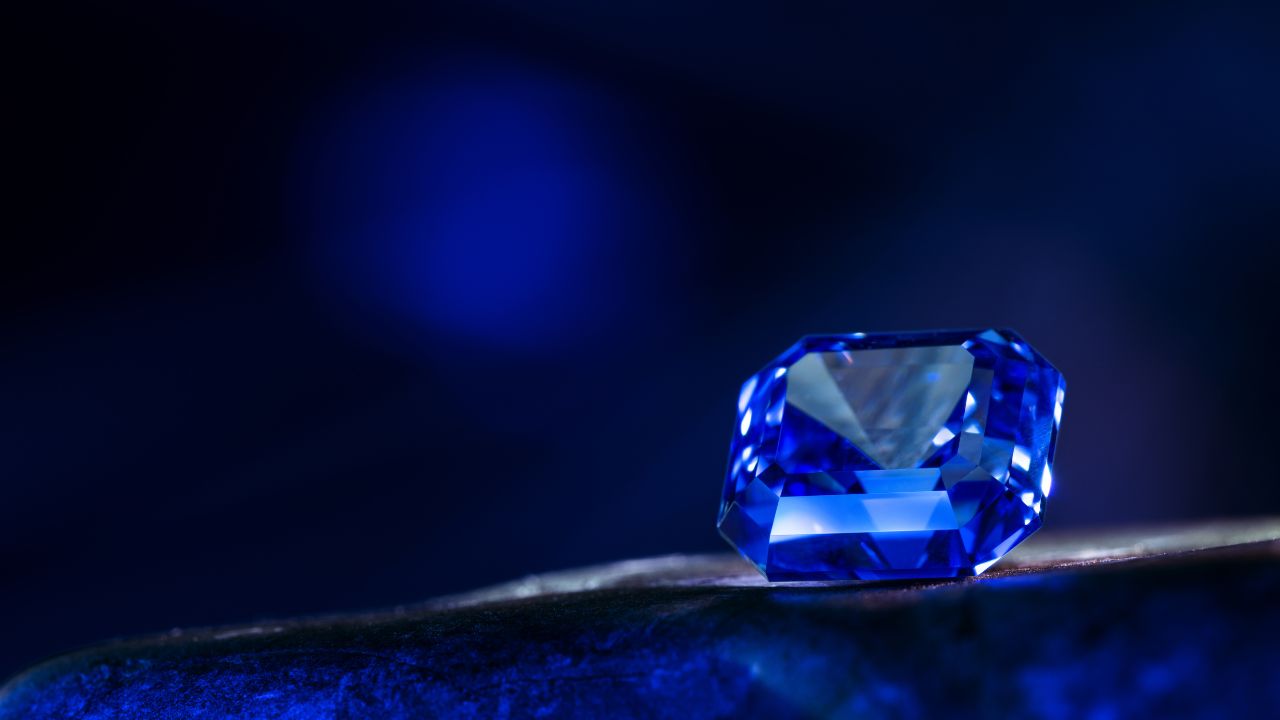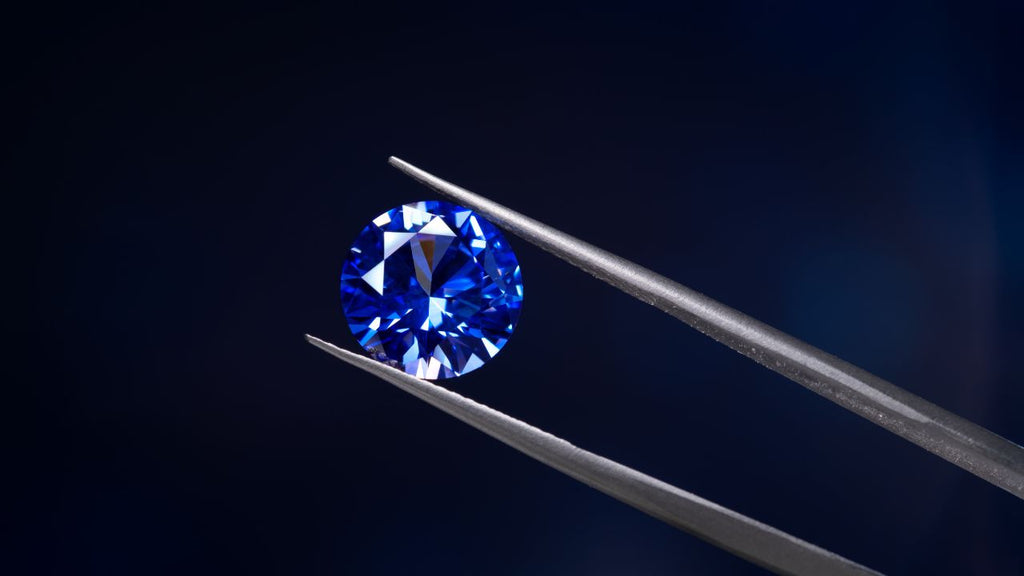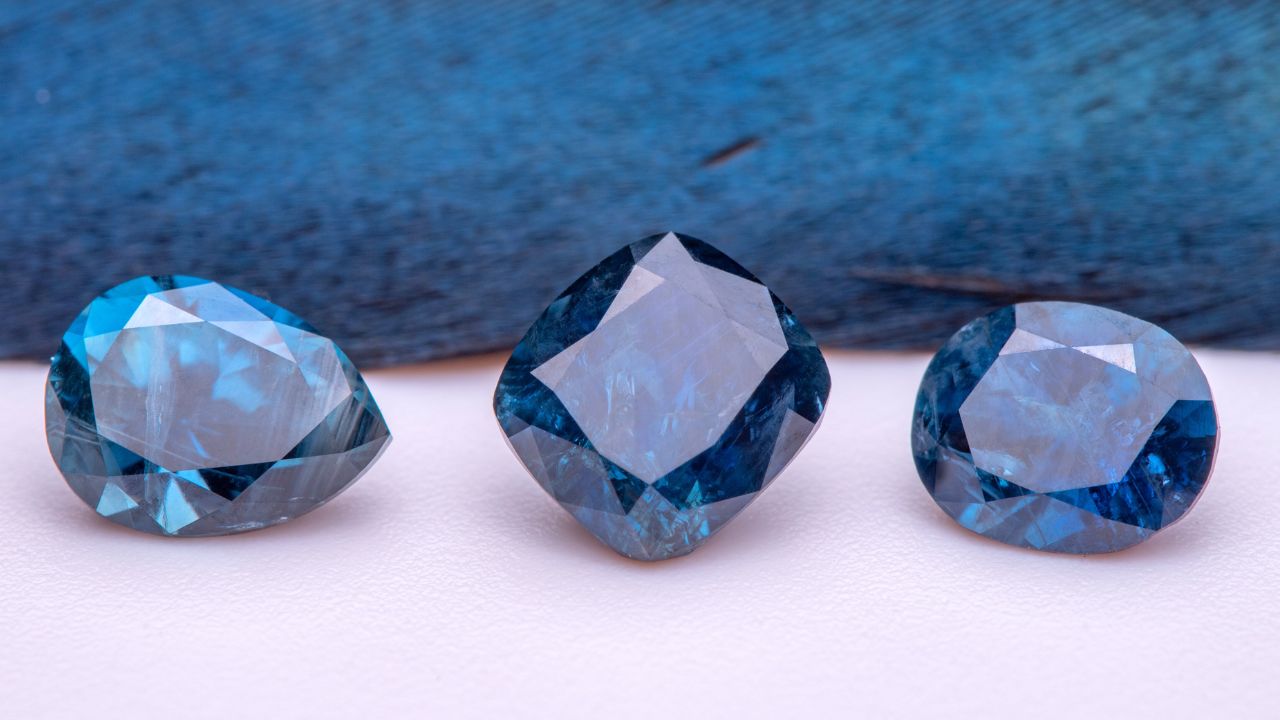
How Can I Tell If My Blue Sapphire Is Real
Blue sapphires dazzle with their deep, rich color, but how can you be sure that sparkling gem is authentic? Identifying a real sapphire requires examining several key characteristics. From assessing color saturation to judging clarity and cut quality, professionals utilize a range of tests and advanced tools. Understanding some basic methods used to separate natural from synthetic stones empowers shoppers to avoid fraud.
This article will outline the distinct traits that signify a genuine blue sapphire, arming readers with insider knowledge from gemological experts so smart purchases become possible.
Understanding Blue Sapphire Colors and Treatments
When it comes to blue sapphires, the color is one of the key factors in determining its authenticity. Blue sapphires can come in various shades, ranging from light blue to deep blue, and even greenish or purplish hues. It's important to note that most blue sapphires undergo heat treatment to enhance and intensify their color. This heat treatment is a widely accepted practice in the gemstone industry and does not affect the value or authenticity of the sapphire. However, it is important to be aware that synthetic blue sapphires are also available on the market, which are chemically and optically identical to natural sapphires but are typically lower-priced options.
Enhancement treatments are undertaken to improve the color of the blue sapphire. These treatments involve heating the gemstone at high temperatures to remove any inclusions or impurities that may hinder the stone's color. This process can result in a more desirable and vibrant blue color.

| Blue Sapphire Color | Treatment |
|---|---|
| Light blue | Commonly heat-treated to enhance color |
| Medium blue | Commonly heat-treated to enhance color |
| Deep blue | Commonly heat-treated to enhance color |
| Greenish or purplish hues | Can occur naturally or through treatment |
| Synthetic sapphire | Chemically and optically identical to natural sapphire, typically lower-priced |
Checking for Flaws and Inclusions
One of the key factors in determining the authenticity of a blue sapphire is to examine its flaws and inclusions. Natural blue sapphires often have unique characteristics that prove their genuineness, such as tiny cracks, mineral deposits, or other internal imperfections. These flaws can be examined using a jeweler's magnifying glass or loupe, allowing you to observe the natural irregularities that are typically absent in synthetic sapphires. By closely inspecting for flaws and inclusions, you can gain valuable insights into the authenticity of the blue sapphire.
On the other hand, synthetic sapphires are typically flawless due to their lab-made production process. They lack the natural imperfections that are commonly found in genuine blue sapphires. Therefore, the absence of flaws or inclusions can be a significant indication that the blue sapphire is not authentic.
By conducting a thorough examination and comparison, you can differentiate between natural and synthetic sapphires based on the presence or absence of these distinct characteristics.
It is important to note that the presence of flaws and inclusions alone is not conclusive evidence of a blue sapphire's authenticity. Other tests and considerations should be taken into account to ensure accurate identification. However, the examination of flaws and inclusions plays a vital role in the overall evaluation process and can provide valuable insights in determining the genuine nature of a blue sapphire.
Scratch Test
One of the most effective methods for determining the authenticity of a blue sapphire is the scratch test. This straightforward test evaluates the hardness of the gemstone, which can provide valuable insights into its genuineness. Blue sapphires rank as a 9 on the Mohs Hardness Scale, second only to diamonds, meaning they should not be easily scratched by other objects.
To conduct the scratch test, take a diamond or a substance known to be harder than sapphire, and gently scratch the surface of the blue sapphire. If there are no visible scratches, it indicates that the gemstone is most likely real. However, if scratches appear, it could be a sign that the blue sapphire is fake or of lower quality.
It's important to note that performing the scratch test requires caution and should be done with care to avoid damaging the gemstone. Additionally, this test should be used in conjunction with other methods to ensure a comprehensive assessment of the blue sapphire's authenticity.
| Test Result | Interpretation |
|---|---|
| No scratches | Indicates a real blue sapphire |
| Visible scratches | Suggests a fake or lower-quality blue sapphire |
Using the Breath Test
Another method to help determine the authenticity of a blue sapphire is the breath test. This simple test involves breathing on the surface of the gemstone to create a fog-like layer. The speed at which the fog clears can provide valuable insights into whether the sapphire is natural or artificial.
If the fog quickly dissipates within a few seconds, it is likely that the blue sapphire is natural. This occurs because natural sapphires have high thermal conductivity, allowing the heat from the breath to disperse rapidly. However, if the fog persists for a longer time, it may indicate that the sapphire is synthetic or a low-quality imitation.
However, persistence suggests a synthetic imitation. While not foolproof alone, combining the breath test with evaluations of color, flaws, treatments, hardness and light reflection allows for a comprehensive assessment so shoppers can avoid fraud and buy with confidence.
| Natural Sapphire | Artificial Sapphire |
|---|---|
| The fog dissipates quickly within a few seconds | The fog persists for a longer time |
| Indicates high thermal conductivity | May indicate a synthetic or low-quality sapphire |

Light Test
One of the methods used to determine the authenticity of a blue sapphire is the light test. By shining a flashlight or a light source onto the gemstone, you can observe how it reflects the light. A genuine blue sapphire will only reflect the color of the stone itself, while a fake sapphire may reflect other colors or exhibit a rainbow-like effect.
The light test relies on the refractive index of a blue sapphire, which measures how light bends as it passes through the gemstone. Since sapphires have a high refractive index, light entering the stone should reflect internally and give off a vibrant, single color. Synthetic or fake sapphires, on the other hand, may have a lower refractive index, causing light to disperse and reflect multiple colors.
To conduct the light test, simply place your blue sapphire on a flat surface and direct a light source towards it. Observe the reflection and pay attention to any color variations or lack thereof. A genuine blue sapphire should display a consistent, single color reflection, indicating its authenticity. However, if you notice any color inconsistencies or a rainbow effect, it is likely a sign that the sapphire is not genuine.

To further differentiate between real and fake blue sapphires, consider the intensity of the reflected light. A genuine blue sapphire will have a rich, deep reflection, while a fake sapphire may appear dull or lack vibrancy. This discrepancy in light reflection can provide valuable insights into the authenticity of the gemstone.
Examining for Composite Sapphire Characteristics
When assessing the authenticity of a blue sapphire, it is also important to examine the gemstone for composite characteristics, such as lead glass fillings. Some sellers may use lead glass to improve the appearance of a sapphire by filling inclusions present in the stone. However, these composite sapphires are of poorer quality compared to natural ones. To identify such sapphires, it is necessary to examine the stone under a microscope for intersecting lines or signs of lead glass fillings.
Composite sapphires typically exhibit intersecting lines that are visible under magnification. These lines indicate the presence of lead glass fillings, which are used to mask flaws or enhance the color of the gemstone.
One can tell if a sapphire has been treated with lead glass by carefully inspecting the surface. Figuring out these characteristics is critical in distinguishing genuine blue sapphires from those treated with composites.
Distinguishing Poor-Quality Sapphires
Aside from lead glass fillings, it is important to recognize other signs of poor-quality sapphires. Sapphires that are poorly cut or shaped, with uneven facets or rough edges, may be of lower quality. These sapphires may also have an uneven color distribution, making them appear dull or lackluster. Anyone can make informed decisions and ensure they are purchasing high-quality blue sapphires by paying attention to these characteristics.| Composite Sapphire Characteristics | Poor-Quality Sapphire Indicators |
|---|---|
| Intersecting lines visible under magnification | Poorly cut or shaped sapphires |
| Signs of lead glass fillings | Uneven facets or rough edges |
| Inconsistent color distribution |

Heat treatments are commonly used in the gemstone industry to enhance the color of blue sapphires. These treatments involve heating the gemstone to high temperatures to improve its appearance. It is important to note that heat-treated sapphires are widely accepted and valued in the market. However, it is also crucial to consider the longevity of the treatment and potential re-treatment requirements.
Some heat-treated sapphires may require re-treatment over time to maintain their vibrant color. When you want to purchase blue sapphires, it is advisable to inquire about the previous treatment history and whether any re-treatment will be necessary in the future. This information can help you make an informed decision and ensure that you are investing in a gemstone that will retain its beauty over time.
In addition to heat-treated sapphires, there are also synthetic sapphires available in the market. Synthetic sapphires are lab-made and offer a more affordable and sustainable alternative to natural sapphires. While synthetic sapphires are chemically and optically identical to their natural counterparts, they are typically priced lower due to their manufactured origin. If you are considering purchasing a synthetic sapphire, it is important to ensure that it is represented and sold as such, with transparency and accurate labeling.
| Authenticity Indicator | Heat-Treated Sapphire | Synthetic Sapphire |
|---|---|---|
| Origin | Naturally occurring gemstone | Laboratory-created gemstone |
| Price | Higher due to market demand | Lower due to manufacturing process |
| Treatment | Heat-treated to enhance color | Manufactured with consistent color |
| Sustainability | May require re-treatment over time | Eco-friendly alternative |

Understanding the treatments and synthetic options available for blue sapphires can help you make an informed decision when considering their authenticity. Whether you choose a heat-treated or synthetic sapphire, it is essential to ensure that the gemstone is accurately represented and priced accordingly.
Wondering if that sparkling blue sapphire on your finger is the real deal? To know for sure, consult a professional gemologist for an official assessment. These certified experts uniquely possess the skills and specialty equipment to conduct an intricate authentication. It's so much more reliable than an online quiz! They carefully analyze tons of factors like clarity, color saturation, flaws - all under high-powered microscopes and fancy devices.
This comprehensive process determines whether the stone is natural or lab-created, heated or treated. Basically, they uncover everything that could impact the gem's quality and value.
Getting a pro gemologist's inspection gives total peace of mind. You'll have an authoritative judgment on your sapphire's authenticity from masters in the art of gem analytics. Rest assured these insightful reports are meticulously done.
| Benefits of Professional Gemological Assessment |
|---|
| Expertise and knowledge of certified gemologists |
| Precision in identifying natural and synthetic sapphires |
| Thorough examination of color, clarity, and treatments |
| Unbiased and trustworthy evaluation |
| Assurance of accurate identification and assessment |

Buying and Selling Authentic Blue Sapphires: Gemstone Investment Tips
When it comes to buying or selling a blue sapphire, it is essential to make informed decisions to ensure authenticity and fair market value. By understanding the characteristics and conducting thorough assessments, you can confidently navigate the market and make wise investments. Here are some gemstone investment tips to consider:
Reach Out to Trusted Sellers
First things first - find an established jeweler or gemstone dealer with satisfied customers and credentials from renowned gemological institutes. These marks of reputation reduce the risk of counterfeits.
Review Documentation Thoroughly
Don't complete a transaction without evaluating certifications from respected labs like GIA or AGL. These contain integral details on the stone's authenticity, origin, treatments, quality - increasing buyer assurance and selling leverage.
Research Up on Market Value
Knowledge is bargaining power! Before naming figures, research current market prices for comparable sapphires. Factor in dimensions, cut quality, rarity. Consulting historical value trends also enables informed investments based on these gems' appreciation potential.
Armed with these pointers on trusted sellers, documentation, and market savvy, you can now navigate the blue sapphire trade with skillful confidence. Do your due diligence and transactions become transparent, ethical, mutually beneficial affairs.
| Key Points for Buying and Selling Authentic Blue Sapphires: |
|---|
|
By following these gemstone investment tips, you can confidently navigate the blue sapphire market and make well-informed decisions when it comes to buying or selling these precious gemstones.
The Value of Blue Sapphire
Blue sapphires hold immense value in the world of gemstones. Their exquisite beauty and rich color make them highly sought after by collectors and jewelry enthusiasts alike. But beyond their aesthetic appeal, blue sapphires also have investment potential, making them a wise choice for those looking to add a valuable asset to their portfolio.
One of the key factors that contributes to the value of blue sapphires is their rarity. Natural blue sapphires are formed under specific geological conditions, making them relatively scarce compared to other gemstones. As a result, their limited availability drives up their market value. Additionally, the intensity and purity of the blue color significantly impact the desirability and price of a blue sapphire.
Investing in blue sapphires can yield substantial returns over time. The market for gemstones, including blue sapphires, has shown consistent growth, making them a stable and potentially lucrative investment. However, it's essential to consider factors such as the quality, origin, and certification of the blue sapphire when making an investment decision.
The Investment Potential in Blue Sapphire
The investment potential in blue sapphire lies in its ability to retain and increase in value over time. As blue sapphires continue to gain popularity, their demand is expected to rise. This growing demand, combined with their limited supply, creates a favorable market environment for potential investors.
When buying a blue sapphire as an investment, it is crucial to consider factors such as the gemstone's quality, color, clarity, and carat weight. High-quality blue sapphires with vibrant, well-saturated colors and minimal inclusions or flaws tend to command higher prices and have greater investment potential.
| Investment Potential Factors | Description |
|---|---|
| Quality | The overall quality of the blue sapphire, including color, clarity, and cut, plays a significant role in its investment potential. |
| Rarity | The scarcity of high-quality blue sapphires contributes to their investment value, as rarity drives up demand and price. |
| Market Demand | Blue sapphires have a strong and growing market demand, indicating favorable conditions for potential investors. |
| Longevity | Blue sapphires have historically retained their value and shown consistent long-term growth, making them an attractive investment option. |
Conclusion
Determining if a blue sapphire is the real deal takes some careful sleuthing. You’ll want to hold that sparkling stone up to the light and scrutinize every facet. Examine the hue, clarity, any teeny flaws or inclusions. See how it reflects light back at you. Check if it's hard enough by trying to scratch the surface. All these clues can help reveal an authentic sapphire.
Still, appraising gems is tricky business. Your best bet is getting a certified gemologist to conduct an official evaluation. These experts have the high-tech tools and breadth of experience to reliably verify authenticity and value. They can separate natural from lab-created, identify any special treatments, and estimate worth for buying or selling.
While examining your sapphire at home can provide initial opinions, take it from the professionals when you really need definitive answers. Combining their expert analysis with your own checks of color, flaws and other markers lets you make the most informed call to determine if you’ve got a true blue beauty.
FAQ
How can I tell if my blue sapphire is real?
By examining factors such as color, flaws, treatments, hardness, and light reflection, you can gain a better understanding of whether your blue sapphire is genuine or not.
What are the different colors and treatments of blue sapphires?
Blue sapphires come in shades of blue, green, yellow, and orange. Most blue sapphires are heat-treated to enhance their color.
How can I check for flaws and inclusions in a blue sapphire?
Natural blue sapphires often have flaws and inclusions, which can be examined using a jeweler's magnifying glass or loupe.
What is the scratch test and how can it determine the authenticity of a blue sapphire?
The scratch test involves scratching the blue sapphire with a diamond or a harder substance to assess its hardness and authenticity.
How can the breath test help in identifying a real blue sapphire?
By breathing on the blue sapphire and observing how quickly the fog clears up, you can determine if it is likely a natural sapphire or an artificial one.
How does the light test assist in verifying the authenticity of a blue sapphire?
The light test involves shining a light source on the blue sapphire and observing how it reflects the light. A real blue sapphire should only reflect the color of the stone itself.
What should I look for to identify composite sapphire characteristics?
By examining the sapphire under a microscope, you can look for intersecting lines or signs of lead glass fillings, which can indicate a composite or lower-quality sapphire.
What should I consider regarding heat treatments and synthetic sapphires?
Heat treatments are common in the gemstone industry to enhance the color of blue sapphires. Synthetic sapphires offer a more affordable and sustainable alternative to natural sapphires.
How can I seek professional gemological assessment for my blue sapphire?
Certified gemologists have the expertise and tools to analyze the gemstone and provide an official evaluation of its authenticity.
How can I make informed buying and selling decisions for blue sapphires?
By applying the knowledge gained from testing methods and characteristics, you can confidently determine the authenticity and market value of a blue sapphire.
What is the value of blue sapphires?
Blue sapphires are highly prized gemstones known for their beauty and astrological significance. Understanding their value and investment potential can guide your decision-making process.
How should I authenticate a blue sapphire?
Authenticating a blue sapphire can be a meticulous process, but seeking professional gemological assessment is the most reliable way to determine its authenticity.



